Distribution
Prior to the colonisation of Aotearoa by humans, Hamilton’s frogs would have had a much greater distribution, occurring from the Hawke’s Bay region, through to Wellington, and down to Punakaiki in the South Island, whilst their sister species, Archey’s frog (Leiopelma archeyi), would have occurred in the northwestern North Island.
However, at the time of their discovery, they had only survived on Takapourewa/Stephen’s Island and Te Pākeka/Maud Island, in the Marlborough Sounds (Worthy, 1987; van Winkel et al., 2018; Bishop et al., 2018).
They have since been translocated from both Maud Island and Stephen’s Island to several other islands in the Marlborough Sounds (including Long Island, Motuara Island and Nukuwaiata), and to Zealandia — a mainland sanctuary in Wellington.
Обращение с черепахой Гамильтона и ее темперамент.
Хотя со временем пятнистые прудовые черепахи учатся узнавать своих хозяев и могут приходить к ним за едой, большинство водных черепах не являются хорошими домашними животными для маленьких детей, и с ними следует обращаться с осторожностью. Молодые черепахи пугливы и проводят много времени, прячась в водных растениях, под подводными каменными, пещерами и бревнами
Водные черепахи также могут быть довольно дорогими в содержании так как им нужны большие вольеры, фильтрующее оборудование, кондиционеры для воды, а также им требуется частая подмена воды и контроль за условиями их содержания в неволе
Молодые черепахи пугливы и проводят много времени, прячась в водных растениях, под подводными каменными, пещерами и бревнами. Водные черепахи также могут быть довольно дорогими в содержании так как им нужны большие вольеры, фильтрующее оборудование, кондиционеры для воды, а также им требуется частая подмена воды и контроль за условиями их содержания в неволе.
При правильном оформлении исскуственный водоём с пятнистыми прудовыми черепахами может стать красивым и захватывающим дополнением к домашней обстановке.
Представьте себе одну из самых красивых черепах в мире в вашем доме, в красивом аквариуме с чистой пресной водой и пышными водными растениями, которая процветает под вашим внимательным уходом!
История
Свое научное название получила в честь американского энтомолога чешского происхождения Джеймса Цетека, прославившегося исследованиями в области влияния химикатов на термитов и способов защиты мебели от их нашествия. Ее изображение размещено на билетах национальной панамской лотереи, поэтому многими воспринимается как символ страны.

Это земноводное является одним из самых ядовитых существ на нашей планете. Для защиты от хищников на поверхности его тела содержится нейротоксин тетродотоксин, имеющий нейропаралитическое действие. Его концентрации вполне достаточно, чтобы отправить на тот свет нескольких человек. Местные индейцы традиционно смазывают им наконечники стрел перед охотой и содержат этих опасных, но симпатичных существ в качестве домашних питомцев.
Defense
Hamilton’s frogs are not able to make a sound in order to communicate with each other or to ward off predators. However, when they are attacked, they can make a squeaking or chirping sound. This squeaking sound varies between individuals. The pitch of the squeak seemed to be inversely correlated with the size of the frog. Smaller frogs have higher squeaks. Also, temperature affects how long the frog will squeak for. In colder temperatures, they will squeak for longer amounts of time. The squeaks are suspected of coming from forced expulsion of air from their lungs when startled, as they have no true voice box. Other than in the case of a predator attack, Leiopelma hamiltoni make no other sounds. If they are attacked, they will get into a stiff-legged stance and try to make themselves look as big as possible. They will extend their legs and raise their body, and then butt their heads. This head-butting, accompanied with the striped glands along its back, are components of an anti-predator defense adapted by terrestrial species. They will also emit a mal-tasting secretion from their granular glands if they are attacked to prevent a predator from eating it.
Breeding biology
As with all of our endemic frog species, the Hamlton’s frog is oviparous (egg-laying), laying between 1-19 eggs in damp recesses on the ground, in trees, or in the crown of tree ferns. After the deposition of eggs by the female, the male takes sole responsibility for their protection, guarding the eggs until they hatch about 14-21 weeks later. As is the case with its sister species, the Archey’s frog (Leiopelma archeyi), tadpoles have no aquatic stage, instead remaining within the egg to hatch out as fully-formed froglets, at which point they are carried around on the male’s back for several weeks until metamorphosis is complete (a process often referred to as exovivipary).
Popular television series
- The Crown (TV series) — historical drama web television series about the reign of Queen Elizabeth II, created and principally written by Peter Morgan, and produced by Left Bank Pictures and Sony Pictures Tel…
- Friends — American sitcom television series, created by David Crane and Marta Kauffman, which aired on NBC from September 22, 1994, to May 6, 2004, lasting ten seasons. With an ensemble cast sta…
- Young Sheldon — spin-off prequel to The Big Bang Theory and begins with the character Sheldon…
- Modern Family — American television mockumentary family sitcom created by Christopher Lloyd and Steven Levitan for the American Broadcasting Company. It ran for eleven seasons, from September 23…
- Loki (TV series) — upcoming American web television miniseries created for Disney+ by Michael Waldron, based on the Marvel Comics character of the same name. It is set in the Marvel Cinematic Universe, shar…
- Game of Thrones — American fantasy drama television series created by David Benioff and D. B. Weiss for HBO. It…
- Shameless (American TV series) — American comedy-drama television series developed by John Wells which debuted on Showtime on January 9, 2011. It…
Popular video games
- Minecraft — sandbox video game developed by Mojang Studios. Created by Markus «Notch» Persson in the Java programming language and released as a public alpha for personal computers in 2…
- Grand Theft Auto V — 2013 action-adventure game developed by Rockstar North and published by Rockstar Games. It is the first main entry in the Grand Theft Auto series since 2008’s Grand Theft …
- Roblox — online game platform and game creation system that allows users to program games and play games created by other users. Founded by David Baszucki and Erik Cassel in 2004 and released in…
- Baldur’s Gate III — upcoming role-playing video game developed and published by Larian Studios for Microsoft Windows and the Stadia streaming service. It is the third main game in the Baldur’s …
- Alan Wake — action-adventure video game developed by Remedy Entertainment and published by Microsoft Studios, released for the Xbox 360 and Microsoft Windows. The story follows best-selling thri…
- Fortnite — online video game developed by Epic Games and released in 2017. It is available in three distinct game mode versions that otherwise share the same general gameplay and game engine: …
- Super Mario RPG — is a role-playing video game developed by Square and published by Nintendo for the Super Nintendo Entertainment System in 1996. It was directed by Yoshihiko Maekawa and Chihiro Fujioka and produced by…
Пискуньи (Arthroleptidae)
Беззубница Шьётца (Cardioglossa schioetzi) — уязвимый вид
Белобрюхая подкаменка (Leptodactylodon albiventris) — вымирающий вид
Большая пискунья (Arthroleptis tanneri) — вымирающий вид
Горная древесница (Leptopelis susanae) — вымирающий вид
Гребнистая коготница (Astylosternus laurenti) — вымирающий вид
Длиннопалая древесница (Leptopelis xenodactylus) — вымирающий вид
Долинная древесница (Leptopelis karissimbensis) — уязвимый вид
Древесница Паркера (Leptopelis parkeri) — вымирающий вид
Звонкоголосая коготница (Astylosternus fallax) — уязвимый вид
Зернистая подкаменка (Leptodactylodon axillaris) — вид на грани исчезновения
Изящная беззубница (Cardioglossa pulchra) — вымирающий вид
Камерунская беззубница (Cardioglossa oreas) — вымирающий вид
Колючая подкаменка (Leptodactylodon polyacanthus) — уязвимый вид
Коренастая коготница (Astylosternus schioetzi) — вымирающий вид
Краснобрюхая подкаменка (Leptodactylodon erythrogaster) — вид на грани исчезновения
Перепончатая древесница (Leptopelis palmatus) — уязвимый вид
Пестробрюхая подкаменка (Leptodactylodon ventrimarmoratus) — уязвимый вид
Пещерная пискунья (Arthroleptis troglodytes) — вид на грани исчезновения
Подкаменка Мертенса (Leptodactylodon mertensi) — вымирающий вид
Подкаменка Перре (Leptodactylodon perreti) — вымирающий вид
Пятнистая коготница (Astylosternus nganhanus) — вид на грани исчезновения
Степная древесница (Leptopelis yaldeni) — уязвимый вид
Стройная коготница (Astylosternus perreti) — вымирающий вид
Танзанийская древесница (Leptopelis vermiculatus) — вымирающий вид
Темнобрюхая беззубница (Cardioglossa melanogaster) — уязвимый вид
Трёхполосая беззубница (Cardioglossa trifasciata) — вид на грани исчезновения
Узорчатая коготница (Astylosternus ranoides) — вымирающий вид
Чернобрюхая подкаменка (Leptodactylodon ornatus) — вымирающий вид
Эфиопская древесница (Leptopelis ragazzii) — уязвимый вид
Ядовитая беззубница (Cardioglossa venusta) — вымирающий вид
Arthroleptis aureoli — вымирающий вид
Arthroleptis bioko — вымирающий вид
Arthroleptis fichika — вымирающий вид
Arthroleptis francei — уязвимый вид
Arthroleptis kidogo — вид на грани исчезновения
Arthroleptis kutogundua — вид на грани исчезновения
Arthroleptis nguruensis — уязвимый вид
Arthroleptis nikeae — вид на грани исчезновения
Arthroleptis nlonakoensis — вымирающий вид
Arthroleptis perreti — вымирающий вид
Arthroleptis xenodactylus — вымирающий вид
Cardioglossa alsco — вымирающий вид
Cardioglossa manengouba — вид на грани исчезновения
Leptodactylodon bueanus — вымирающий вид
Leptodactylodon stevarti — вымирающий вид
Leptodactylodon wildi — вид на грани исчезновения
Leptopelis anebos — вымирающий вид
Leptopelis grandiceps — уязвимый вид
Внешние признаки лейопельмы Гамильтона.
Лейопельма Гамильтона, в основном, коричневого цвета. По всей длине головы на каждой стороне проходит темно-коричневая или черная полоса через глаза. В отличие от большинства лягушек, которые имеют щелевидные зрачки, у лягушки Гамильтона необыкновенные для земноводных круглые зрачки. На спине, по бокам и на конечностях видны рядки гранулированных желез, которые секретируют неприятно пахнущую жидкость, необходимую для отпугивания хищников. Самки обычно крупнее самцов, с длиной тела от 42 до 47 мм, а самцы имеют размеры в диапазоне от 37 до 43 мм. Как и другие виды семейства Leiopelmatidae они имеет ребра, которые не срастаются с позвонками. Молодые лягушки являются миниатюрной копией взрослых особей, но только имеют хвосты. В ходе развития эти хвосты постепенно исчезают, и лягушка Гамильтона приобретает вид взрослой стадии развития.
Размножение лягушки Гамильтона.
В отличие от других родственных видов, лягушки Гамильтона не привлекают партнера громкими звуками. Они лишены перепонок, а также голосовых связок, поэтому никогда не квакают. Тем не менее, земноводные способны издавать тонкий писк и пищат во время сезона размножения.
Лягушки Гамильтона размножаются один раз в год, в период с октября по декабрь. Икринки откладываются в прохладных, влажных местах, часто под камнями или бревнами, которые присутствуют в лесу. Они укладываются в несколько стопок, которые, как правило, слипаются. Количество яиц колеблется от семи до девятнадцати. Каждое яйцо имеет желток, окруженный плотной капсулой, которая состоит из трех слоев: внутренней желточной оболочки, среднего гелеобразного слоя и защитного внешнего слоя.
Развитие длится от 7 до 9 недель для них, еще 11-13 недель происходит превращение во взрослую лягушку, при этом рассасывается хвост и развиваются конечности. Развитие прямое, так как головастики не образуются, маленькие лягушата являются миниатюрными копиями взрослых лягушек. Все превращение занимает период от 3 до 4 лет до достижения половой зрелости, в этот период молодые лягушки имеют длину тела 12 – 13 мм.
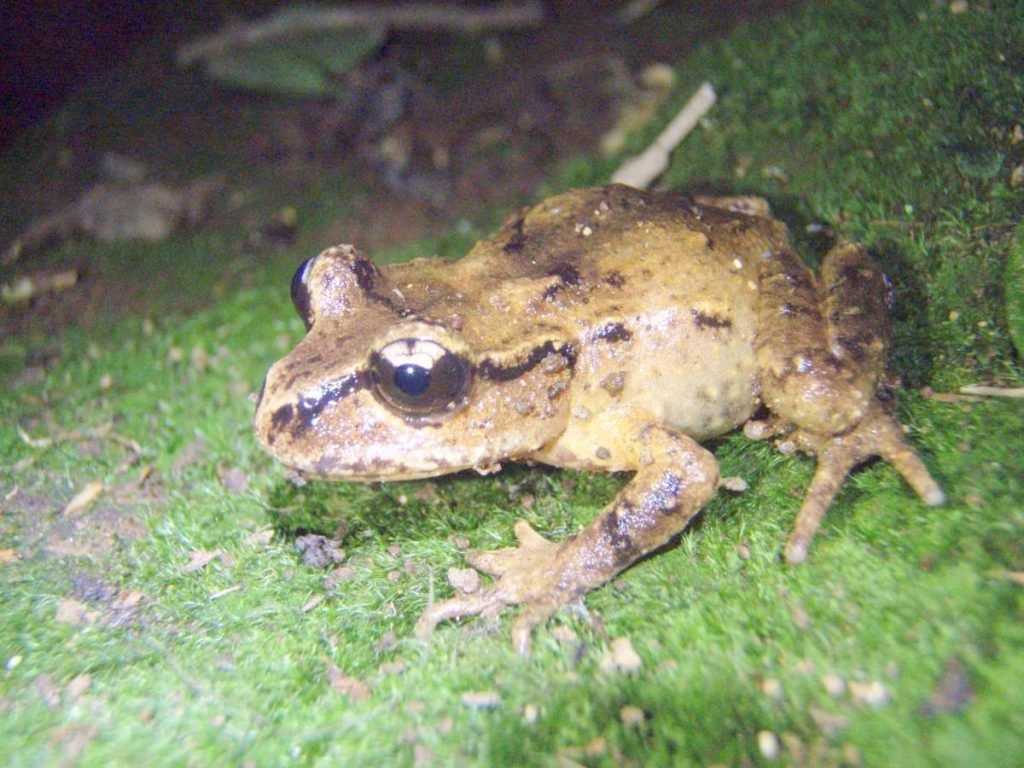
Самец остается в том месте, где отложены икринки, охраняет кладку от недели до одного месяца. После того, как икра отложена, он защищает гнездо с яйцами, поддерживает относительно стабильную среду для развития потомства. Такая забота о потомстве увеличивает шансы на выживание у молодых лягушек, уменьшая хищничество, и, возможно, развитие грибковой инфекции.
Среда обитания
Данный вид населяет острова Стивенса и Мод в области Марлборо Саундс. Находимые останки свидетельствуют, что ранее вид был более широко распространен — в том числе в таких областях, как Уайтома, Хокс-Бей, Уэрарапа и северо-запад области Нельсона.
Лягушки Гамильтона исторически населяли прибрежные леса, но теперь территория обитания ограничивается 600 квадратными метрами скалистой местности, известной как «банк лягушек» на пике Стефенс-Айленд. Эта область была первоначально покрыта густой растительностью, но с расширением пастбищ для выпаса сельскохозяйственных животных этот район потерял лесные насаждения. Некоторые участки этой территории были восстановлены до первоначального состояния, после того как был построен забор, сдерживающий передвижение овечьих отар.
Disease
As is the case with all of Aotearoa’s herpetofauna, the diseases and parasites of our endemic Leiopelma frogs are poorly understood, and incomplete. However, one of the greatest threats amphibians are facing is the rapid spread of the deadly chytrid fungus, Batrachochytrium dendrobatidis (Bd). This, and other species of Batrachochytrium have impacted many populations of amphibians around the world (Berger et al. 1999). Some evidence indicates that this may have resulted in a major population crash of its sister species, the Archey’s frogs, in the Coromandel during the 1990’s (Bell et al. 2004). However, lab and field studies of our native frogs indicate that Leiopelma are highly resistant to this fungus, with some wild individuals persisting after being infected with no obvious adverse effects, whilst captive animals have been seen to eliminate their own infection (Bishop, 2009; Eda et al., 2023)).
Whilst, Bd is a major concern for wild populations, some diseases are more prevalent in captive situations. For example, in captivity, Leiopelma frogs are known to develop metabolic bone disease (MBD) and osteofluorosis (accumulation of fluoride in bones) due to improper husbandry (lack of UVB light, and excess fluoride in water bodies) (Shaw, 2012; Shaw et al., 2012).
Overview
The New Zealand primitive frogs’ defining characteristics are their extra vertebrae (for a total of nine) and the remains of the tail muscles (the tail itself is absent in adults, although it is present in the younger frogs, which need the extra skin surface until their lungs are fully developed). The family Ascaphidae (found only in North America), of the same suborder, shares these primitive characteristics, hence the two have often been described as related, or even part of the same family.
Late jump recovery is unique in Leiopelmatidae. When leiopelmatid species jump, they land in a «belly flop» fashion, repositioning their limbs for takeoff for the next jump only after hitting the ground with the ventral surface of their torsos. The appearance of early jump recovery in more advanced taxa is a key innovation in anuran evolution.
They are unusually small frogs, only 5 cm (2.0 in) in length. Most species lay their eggs in moist ground, typically under rocks or vegetation. After hatching, the tadpoles nest in the male’s back, all without the need for standing or flowing water. However, Hochstetter’s frog lays its eggs in shallow ponds and has free-living tadpoles, although they do not swim far from the place of hatching, or even feed, before metamorphosing into adult frogs.Lifespans may be long (more than 30 years) for such small organisms.
Introduced fauna are thought to have had a negative impact on these native frogs, with 93% of all reported predation events on native frogs being attributed to introduced fauna, primarily ship rats.
Description
They are mostly light brown in colour, although some green individuals have also been observed[citation needed]. A single dark stripe runs along each side of the head and through the eye. There is no webbing between the hind toes, and the fingers are not webbed. These frogs have a snout length of 5.5 mm, and thighs that can reach up to 14.8 mm.
Leiopelma hamiltoni is a very small frog species, with males being even smaller than females. Males have a snout-vent length of up to 43 millimeters and up to 49 millimeters for females. They are typically a brown color which can range from very light brown to almost black. Some have also been spotted having a green color. They also have black spots covering their bodies. Unlike other frogs, they have very little to no webbing on their hind toes and also do not have external eardrums. They have a row-like design down the back and sides of their body which are made up of callus-like glands in their skin. This coloration allows the frogs to blend in well with their surroundings. These rows start right at the back side of the eye, with the middle row being the largest and most distinct. The end of this middle row terminates at what scientists called the paratoid gland. The lines are also seen on the legs, feet, and arms but are less prominent than the ones on its back.
Разведение черепахи Гамильтона
Разведение Черепахи Гамильтона в неволе простое. Взрослые особи размножаются в течение всей весны, и самка обычно откладывает две кладки от шести до 10 яиц каждый год. Яйца следует инкубировать в инкубаторе при температуре 28 – 29°C. Молодь появляются через 60-65 дней.
Детёныши черепашки растут в теплой среде с чистой фильтрованной водой. Их можно содержать в 76 – литровом аквариуме или в вольере аналогичного размера с внешним фильтром, местом для купания, тепловыми и ультрафиолетовыми лампами над поверхностью и несколькими живыми водными аквариумными растениями, как плавающими на поверхности воды, так и подводными формами растений.
Молодые черепашки будут питаться самыми разнообразными насекомыми, личинками насекомых и мелкой рыбой, в дополнение к двух или трёх разовым питанием сухим кормом для черепах каждый день. Я предлагаю смесь гранул, содержащих рыбу, криль и водоросли спирулины.
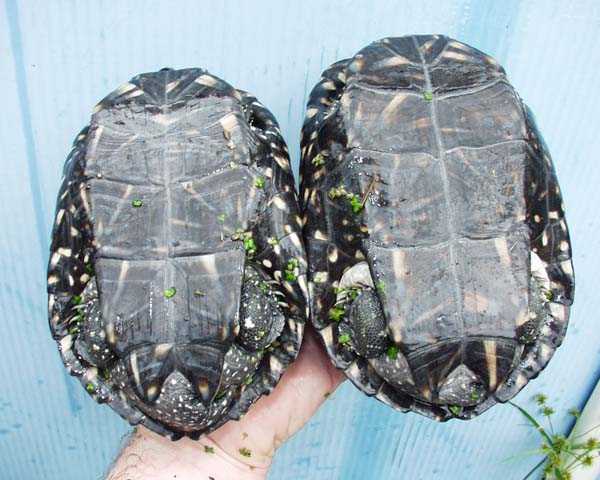
Особенности поведения лягушки Гамильтона.
Лягушки Гамильтона являются оседлыми, все особи обитают в непосредственной близости друг от друга в доступной среде обитания и не показывают социальное поведение.
Лягушки Гамильтона имеют глаза, которые хорошо приспособлены воспринимать изображение в условиях низкой интенсивности света, вследствие наличия большого количества рецепторных клеток.
Окраска кожных покровов является примером приспособления к фону окружающей среды. Лягушки Гамильтона окрашены в коричнево – зеленоватый цвет, который позволяет им маскироваться среди окружающих камней, бревен и растительности. В случае появления хищников, земноводные замирают на месте, стараясь оставаться незамеченными, и могут долго сидеть, замерев в одной позе, пока минует угроза для жизни. Лягушки Гамильтона отпугивают хищников вертикальным положением тела с вытянутыми ногами. Они способны выделять вещества с неприятным запахом из зернистых желез, чтобы избежать нападения хищников.
Popular articles
- Javier Milei — Argentine libertarian economist, author, radio conductor and public speaker sympathetic to the Austrian School of economic thought. He became widely known for his regular …
- Jimmy Carter — American politician, philanthropist, and former farmer who served as the 39th president of the United States from 1977 to 1981. A member of the Democratic Party, he previ…
- UEFA Euro 2024 — The 2024 UEFA European Football Championship , commonly referred to as UEFA Euro 2024 or simply Euro 2024 , will be the 17th edition of the UEFA European Championship, the quadrennial internationa…
- Argentina — country located mostly in the southern half of South America. Sharing the bulk of the Southern Cone with Chile to the west, the country is also b…
- Sam Altman — American entrepreneur, investor, programmer, and blogger. He is the former president of Y Combinator and now the CEO of OpenAI. Early life and education. …
- Rosalynn Carter — American who served as First Lady of the United States from 1977 to 1981 as the wife of President Jimmy Carter. For decades, she has been a leading advocate for numerou…
- Next Argentine presidential election — Next Argentine presidential election — presidential election in Argentina….
Пресмыкающиеся Новой Зеландии
Среди новозеландских пресмыкающихся нет змей. Их ввоз на архипелаг категорически запрещен. В классе пресмыкающихся царствуют ящерицы.
Гаттерия
Входит в отряд клювоголовых. Длина тела ящерицы-гаттерии около 80 см. Вес доходит до 1.3 кг. Эти создания живут около 60 лет. Зоологи нашли гаттерий, прошивших 100 лет. На основных новозеландских островах ящерицы уже не встречаются.
Гаттерии способны к размножению начиная с 20 лет. Откладывают яйца 1 раз в 4 года. Низкие темпы воспроизводства могут привести к окончательному исчезновению этих пресмыкающихся.
Гаттерия обладает, так называемым, теменным глазом. Это архаичный орган способный реагировать на уровень освещенности. Теменной глаз не формирует изображений, предполагается, что он облегчает ориентацию в пространстве.

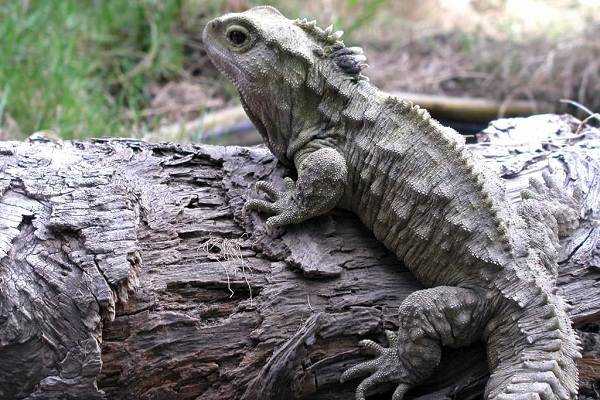
Новозеландские гекконы
Новозеландские живородящие гекконы. Основное время проводят в кроне деревьев, где ловят насекомых. Цвет тела соответствует среде обитания: коричневый, иногда зеленый. Род живородящих гекконов-аборигенов насчитывает 12 видов.
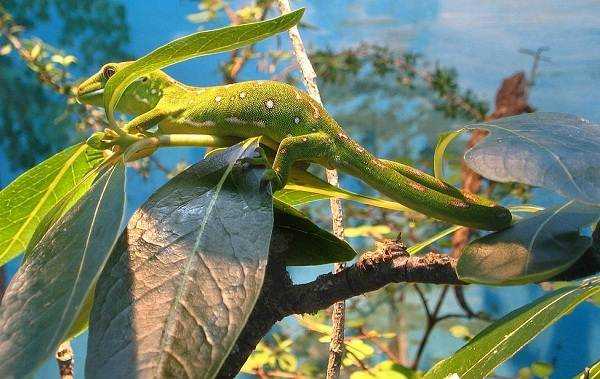
Новозеландские зеленые гекконы. Эндемичный род пресмыкающихся. Ящерицы длиной 20 см. Тело окрашено в зеленый цвет, дополнительную маскировку придают светлые с обводами пятна. Основное время проводит в кустарниковых зарослях. Питается насекомыми, беспозвоночными. Род содержит 7 видов ящериц.

Новозеландские сцинки
В этот род входит 20 видов сцинков, населяющих Новую Зеландию. Основной особенностью сцинков является покров, напоминающий рыбью чешую. Подкожный слой укреплен костными пластинами — остеодермами. Ящерицы насекомоядные, распространены во всех биотопах архипелага.

Additional Information
Key: Profile Photos Video Audio
Archey’s Frog — Leiopelma archeyi
Archey’s frog is found on the North Island of New Zealand.
Source: Arkive Intended Audience: General Reading Level: Middle School Coastal Tailed Frog — Ascaphus truei
The coastal tailed frog is found in cold, clear, rocky streams in wet forests.
Source:California Herps Intended Audience: General Reading Level: Middle School
Coastal Tailed Frog — Ascaphus truei
Coastal tailed frog tadpoles have large sucker-like mouths that help them cling to rocks in fast moving streams.
Source:Washington Dept. of Natural Resources Intended Audience: General Reading Level: High School
Coastal Tailed Frog — Ascaphus truei
Coastal tailed frogs are found along the Pacific coast of North America from southern British Columbia to northern California.
Source:Amphiweb Intended Audience: General Reading Level: High School Hochstetter’s Frog — Leiopelma hochstetteri
Hochstetter’s Frog is found in New Zealand.
Source: Arkive Intended Audience: General Reading Level: Middle School
Hochstetter’s Frog — Leiopelma hochstetteri
Hochstetter’s Frog can remain still for long periods of time.
Source: AmphibiaWeb Intended Audience: General Reading Level: High School Maud Island Frog — Leiopelma pakeka
The Maud Island frog is found on Maud Island in New Zealand.
Source: Arkive Intended Audience: General Reading Level: Middle School
Rocky Mountain Tailed Frog — Ascaphus montanus
Rocky Mountain tailed frog tadpoles take 1 to 4 years to become frog, depending on water temperature.
Source:Montana Field Guide Intended Audience: General Reading Level: Middle School
Rocky Mountain Tailed Frog — Ascaphus montanus
Rocky Mountain tailed frogs are found in the Rocky Mountains and Colombia Mountains of Idaho, western Montana, northeastern Oregon, and southeastern Washington to southeastern British Columbia .
Source:California Herps Intended Audience: General Reading Level: Middle School
Rocky Mountain Tailed Frog — Ascaphus montanus
Rocky Mountain tailed frogs lack some of the structures used to make sounds (tongue and vocal sacs) found in other frogs.
Source:Washington Dept. of Natural Resources Intended Audience: General Reading Level: High School
Rocky Mountain Tailed Frog — Ascaphus montanus
The Rocky Mountain tailed frog is also known as the inland tailed frog.
Source:Amphiweb Intended Audience: General Reading Level: High School Stephens Island Frog — Leiopelma hamiltoni
The Stephens Island frog is found on a single rock stack on New Zealand’s Stephens island. It is also known as Hamilton’s frog.
Source: Arkive Intended Audience: General Reading Level: Middle School
Behavior
These frogs are nocturnal, so they are the most active at night. They will occasionally come out during the day to feed, as long as there are humid and moist conditions. They prefer cool and misty nights and are most active when temperatures are between 8 degrees celsius to 14 degrees celsius. They do not travel far, and will usually stay within a 5 meter radius for multiple years at a time. Individuals will also hide and rest in the same spot, typically in a damp rock or log crevice. The frogs will co-habit these retreat sites, with multiple frogs residing inside at a time. This species typically live very closely to one another which would signal socialith. However, since their habitats have become so small, it is unclear whether they do this for social reasons or simply because there is not much space to spread out. Leiopelma hamiltoni also live for an extremely long time, compared to other frog species. Tagged frogs had been found to have lived up to 30 years after their initial tagging. Scientists have estimated that their likely life span is around 23–33 years. They also have unique hunting habits, as they catch their prey by catching it directly with their mouths, rather than with their tongues.
Распространение
Ателоп Цетека принадлежит к числу эндемических видов Центральной Америки. В настоящее время встречается только в центральных регионах Панамы. Последние популяции золотой лягушки сохранились в провинциях Западная Панама и Кокле. Они обитают в окрестностях небольшого городка Эль Валье де Антон и в Национальном парке Альтос де Кампана на высотах 330-1300 м над уровнем моря.
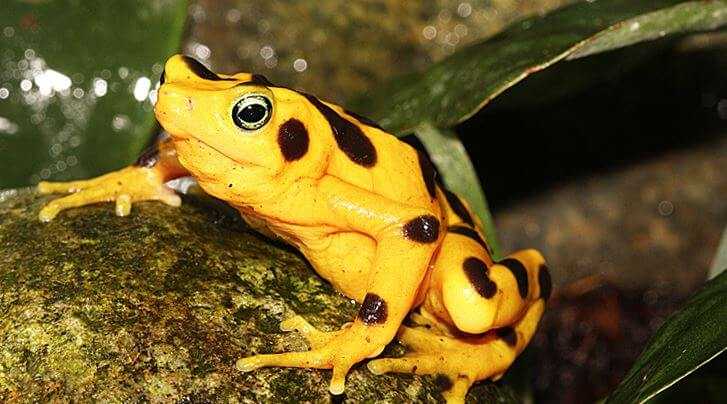
- Ушастый ёж
- Ихтиозавр
- Паук-крестовик
- Пресмыкающиеся
Вид Atelopus zeteki находится на стадии вымирания. В зоопарке Хьюстона (США) ведутся работы по его разведению в неволе с дальнейшим поселением в условиях естественной среды обитания. Амфибии населяют дождевые тропические леса и могут вести как наземный, так и древесный образ жизни.
Лягушки часто подвергаются заражению смертельно опасным для них грибком Batrachochytrium dendrobatidis. Они не способны выработать против него иммунитет, что и привело к катастрофическому снижению их численности. Эффективных лекарств от этой напасти создать до сих пор не удалось.
Popular books
- Book of Revelation — The Book of Revelation is the final book of the New Testament, and consequently is also the final book of the Christian Bible. Its title is derived from the first word of the Koine Greek text: apok…
- Book of Genesis — account of the creation of the world, the early history of humanity, Israel’s ancestors and the origins…
- Gospel of Matthew — The Gospel According to Matthew is the first book of the New Testament and one of the three synoptic gospels. It tells how Israel’s Messiah, rejected and executed in Israel, pronounces judgement on …
- Michelin Guide — Michelin Guides are a series of guide books published by the French tyre company Michelin for more than a century. The term normally refers to the annually published Michelin Red Guide , the oldest…
- Psalms — The Book of Psalms , commonly referred to simply as Psalms , the Psalter or «the Psalms», is the first book of the Ketuvim , the third section of the Hebrew Bible, and thus a book of th…
- Ecclesiastes — Ecclesiastes is one of 24 books of the Tanakh , where it is classified as one of the Ketuvim . Originally written c. 450–200 BCE, it is also among the canonical Wisdom literature of the Old Tes…
- The 48 Laws of Power — non-fiction book by American author Robert Greene. The book…
Overview
The New Zealand primitive frogs’ defining characteristics are their extra vertebrae (for a total of nine) and the remains of the tail muscles (the tail itself is absent in adults, although it is present in the younger frogs, which need the extra skin surface until their lungs are fully developed). The family Ascaphidae (found only in North America), of the same suborder, shares these primitive characteristics, hence the two have often been described as related, or even part of the same family.
Late jump recovery is unique in Leiopelmatidae. When leiopelmatid species jump, they land in a «belly flop» fashion, repositioning their limbs for takeoff for the next jump only after hitting the ground with the ventral surface of their torsos. The appearance of early jump recovery in more advanced taxa is a key innovation in anuran evolution.
They are unusually small frogs, only 5 cm (2.0 in) in length. Most species lay their eggs in moist ground, typically under rocks or vegetation. After hatching, the tadpoles nest in the male’s back, all without the need for standing or flowing water. However, Hochstetter’s frog lays its eggs in shallow ponds and has free-living tadpoles, although they do not swim far from the place of hatching, or even feed, before metamorphosing into adult frogs. Lifespans may be long (more than 30 years) for such small organisms.
Introduced fauna are thought to have had a negative impact on these native frogs, with 93% of all reported predation events on native frogs being attributed to introduced fauna, primarily ship rats.
Общение
Панамские золотые лягушки общаются между собой посредством горловых звуков и замысловатыми движениями лапок. Арсенал коммуникационных сигналов довольно обширный и может передавать сравнительно большой объем информации. Жесты используются в основном для установления иерархической структуры, социальных взаимоотношений, демонстрации враждебности или дружелюбия.
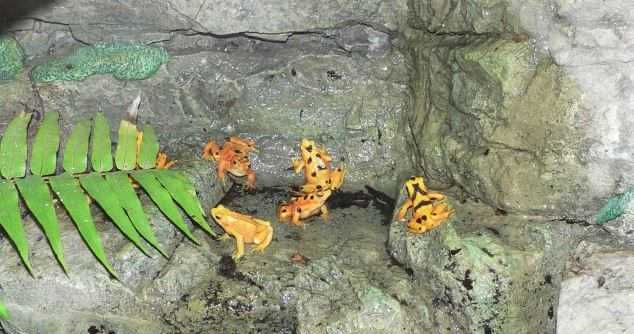
Живые амфибии воспринимают положения конечности неживых манекенов как призыв к действию, могут после неприятной им комбинации приходит в настоящую ярость и атаковать искусственных соплеменников. Звуковые сигналы чаще применяются для привлечения особей противоположного пола и при возникновении опасности.
- 72 факта о растениях
- Животные Сибири
- Спинозавр
- Животные Крыма
- 36 фактов про слонов
- Грызуны
Distribution
Hamilton’s frog live only on a small rocky area on mammal-free Stephens Island in the Cook Strait. Sub-fossils indicate Hamilton’s frog once lived throughout the lower North Island and upper South Island. They live around rocky, moist and grassy areas.
Leiopelma hamiltoni are typically found on the Stephens and Maud Islands, located in the Marlborough Sounds region of New Zealand. Maud island is very small with steep hills, only spanning about 760 acres. The estimated population size of Leiopelma hamiltoni on Maud Island is around 19,000, with the minimum population estimate being around 6,500. The population is much smaller on Stephans Island, with a population estimate of about 200 to 300 individuals. They reside in a small patch at the peak of Stephan’s Island which is known as “frog bank”. However, fossils show that the species may have previously had a larger range, with fossils being found scattered all over New Zealand. Remains have been found at Waitoma, Hawkes Bay, and Wairarapa, which are all located on the North Island of New Zealand. Much of the island has been modified due to farming, forcing all the frogs to live in the same section of rainforest that remains.


























